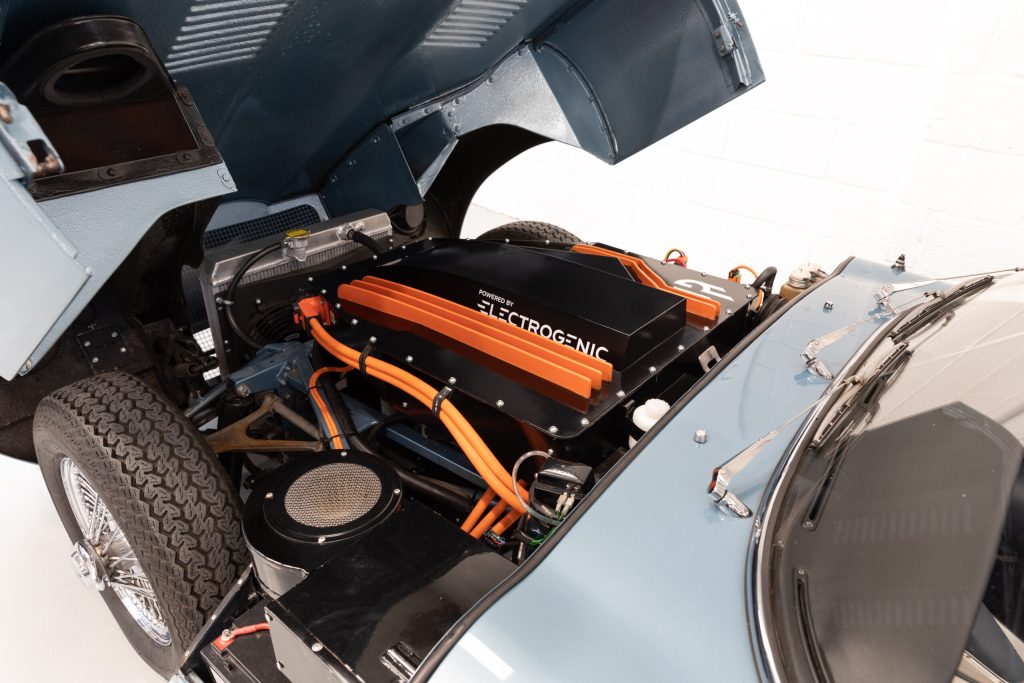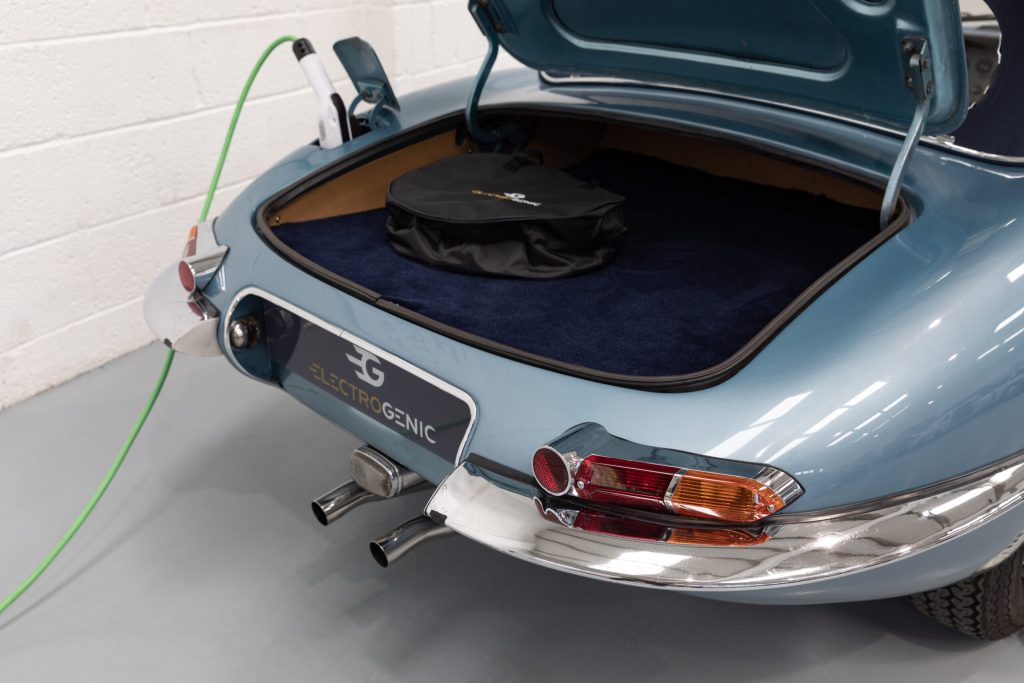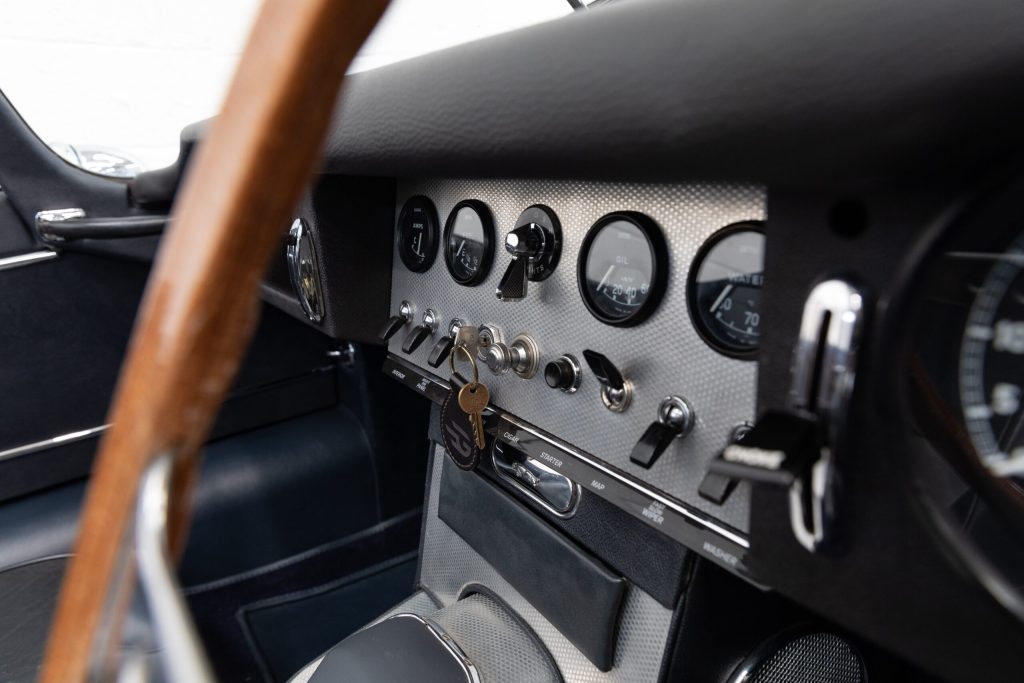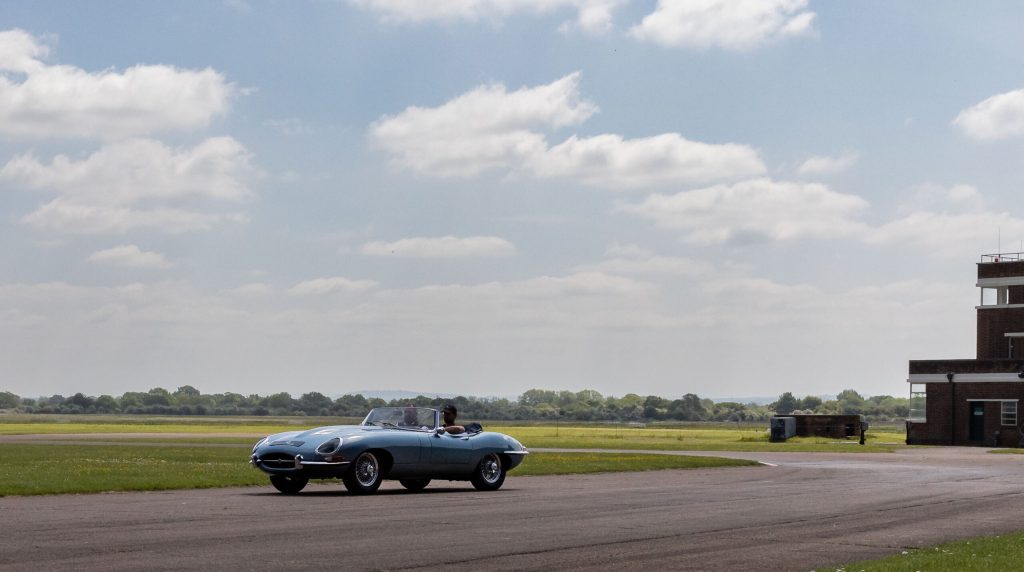It’s a glorious summer’s day. The heat of the sun beating down perfectly balances the cooling air that rushes around the edge of the windscreen and into the cabin of the 1962 Series I Jaguar E-Type roadster. I can smell freshly cut grass as we cruise through country lanes. Above the gentle rumble of tires on road is the sound of birdsong.
There’s no intake noise, no exhaust burble, not an intonation of internal combustion to be heard, however, because this classic Jaguar has been converted to battery power using a circa £94,000 drop-in kit from the specialists at Electrogenic.

Developed by the Oxfordshire firm and available worldwide through a network of approved partners, the kit is a straight swap for the engine and gearbox of an E-Type, from Series I to III. Under the forward-hinged clamshell bonnet is a battery box, and the space originally taken up by the transmission is used to house an electric motor. More batteries sit in the rear, where the fuel tank would normally be.


One of the evils of EV conversions is added weight, and yet this battery-powered E-Type is actually 132 pounds lighter than Jaguar’s original. The example in which I’m riding is fitted with Electrogenic’s smallest (43 kWh) battery pack, but even with the largest one (62 kWh), the driveline swap adds just 110 pounds—the weight of one small passenger—to the donor car.
Behind the wheel is a very relaxed Alex Bavage, Electrogenic’s system architect engineer and partnership manager. As this E-Type is a customer car, not a company-owned demonstrator, I’m starting the drive in the passenger seat, awaiting our arrival at a disused airfield, where I can have a go. As we meander along B-roads lined high with hedgerows, Bavage explains Electrogenic’s conservative approach to its conversions: “We want the car to drive like the original, for you to enjoy driving it like a classic and not a modern EV.”
That means keeping the weight as close to that of the standard car as possible and maintaining the distribution of that weight front to rear. Electrogenic’s philosophy also requires that it avoid the temptation of the crazy performance that electrification can offer: For the E-Type conversion, it offers a 120-kW (163bhp) or a 150-kW (204bhp) motor, depending on a customer’s hunger for speed versus driving range.

A toggle switch on the Jaguar’s turned-aluminium dashboard provides three different drive modes—Standard, Eco, and Performance. Each maps slightly different power, torque, and regeneration curves. The car isn’t set with full one-pedal driving, although if a customer really wanted the feature, Electrogenic’s software could deliver.
We arrive at the airfield, where Bavage explains the controls. To start, you turn the key and push a button, but nothing much happens except for a light appearing on the dash. Customers can pick which switch they want to use to engage drive: On this car, the customer chose to repurpose the choke. Slide it up to go forward, down to go back.
I start in the standard drive-mode setting. Like most electric vehicles, the Jaguar feels pretty eager off the line. Acceleration is linear, and the lovely, wood-rimmed Moto-Lita steering wheel immediately lightens in my hands.
Given that Bavage and his fellow engineers actually took weight out of the car, they felt no need to modify the original suspension, brakes, or steering. When I hit the brake pedal for the first time, this authenticity catches me by surprised: Not much happens for the first inch or so of travel. Finally, the brakes begin to bite, discs and electric motor working together to slow the car down. The car pitches forward as it slows, a behavior quite familiar to E-Type owners, Bavage says.
In Eco mode, the throttle is less responsive than in Standard mode—at least, until you press the pedal fully into the carpet. In Performance mode, the Electrogenic E-Type is probably more sprightly than most of its petrol-powered ancestors, despite not packing much punch on paper: That’s the 358 lb-ft of torque doing its job. Electrogenic claims that even this lowest-powered conversion will reach 60 mph from a standstill in less than six seconds, with the highest spec shaving a second off that. It’s not the internal-organ-rearranging thrust of a current EV, but that was never part of the plan. Imbue a classic car with modern performance, and you’d need to upgrade its handling and stopping ability accordingly.
With a realistic driving range of 150 miles and DC fast charging at up to 60 kW, this electric vehicle won’t require you to stop as much as you might have thought, anyway. Not just a weekend toy, this Jaguar could take you on a real road trip, if not quite at the pace of the Mille Miglia.
Compared to Electrogenic’s Porsche 356 and 911 conversions, the E-Type feels the most suited to silent running. Especially when the sun’s out and the birds are singing.








approximate cost to convert a 1976 TR6 to electric (battery power)?
You’d have to ask Electrogenic but they have done a TR6 before
As interesting and clever that it is I really don’t see the point ..isn’t this just another toy for very rich people who can stand at meets and shows with the latest expensive car? Perhaps I’m missing something and need to join the electric revolution! Perhaps not.
If you want an EV get a Tesla.
Why vandalise a classic?
A guy in USA put an LS3 in a Tesla, so it works both ways!
I think I’d miss the E Type sound track – and synthetic sounds, as some modern performance cars use, is just too naff for words.
Utter madness why?? I drive my series 1 approximately 1k a year it’s completely original and authentic, Intoxicating to drive.
These people Should be arrested!
Complete waste of time, money and effort. In 10-20 years time the electronics will start to fail and you won’t be able to find the right replacement “chip”, plus the battery will need replacing as the 150 mile range reduces to 140, then 130 then 120 and so on. An original gas engine E-Type will still be going strong, being able to do 300 mile trips without thinking about it.
Absolutely ridiculous the whole heart and soul of this Jaguar is that XK engine ,it’s like a human without a heart and brain you have to draw the line somewhere!
I owned a series 1 DHC and would have been overjoyed by this conversion! Grace pace and silence with better performance perfik
What an idea. Putting an electric drive motor into an e type. Is this not an act of folly? An e type takes to the rolling dales and long distance journeys to see a loved one, you cannot do either of these not knowing where and when you can recharge the batteries. It would be sensible to keep electric driven vehicles in the town eg taxis and busses. Not forgetting milk floats.
Wonderful idea, I was just wondering what to do with that £94k burning a hole in my back pocket.
What we should all be doing is to get behind the push for synthetic fuels then no one has to change anything & we can all carry on enjoying our classics as they are meant to be enjoyed.
Yes.
Yes
What’s wrong with you people ? 150 mile range is pathetic, no matter what the fiscal cost of charging, its the TIME cost that’ll ruin your day. This is too much,btoo early for our infrastructure.
I previously published yes, this was in reference to another comment ad NOT an endorsement of the car.
An utterly pointless way to waste £94 thousand pounds, you could recondition any Etype drive train for that. No range, 150 miles maximum distance is utterly useless.
You loose the whole appeal of such a great classic, the firm shouldn’t be allowed to do it.
No !
What does this do to the value of the car? Since it’s no longer original will DVLA insist on a Q plate.
Frankly I think it’s a gimmick.
150 miles! nearly £100K what a joke and by 2028 alternative fuels will make an original e-type co2 neutral.
Time to forget this bastardisation
You might just as well put a fiberglass body on it and call it a Kit Car. What a waste of money.
My 1937 Plymouth is still going strong after 85 years. There is not a car built today that will ever make it that far in life and EV are even worse. In short, you took a Classic Car that has stood the test of time and turned it into a modern throwaway car.
I can see King Charles doing his…! (Has he still got it, or has he had to let it go with the ‘cost of living crisis’? )
Should be outlawed
The appeal is about the looks. I say about my 280SL Pagoda it is such a beautiful car that Mercedes could put an electric transmission in it and sell it today. They couldn’t of course because of the H&S changes.
The same comment applies to this E-Type. If you have a more practical modern vehicle in the garage for most journeys this might appeal as a fun car, and it will take you to city centres. Which may become out of bounds to ICE power if the classic car exemption is withdrawn.
Sacrilege, without a doubt.
What a silly idea. You buy an E type for its sound amongst all its other attributes. If you want silent progression go and buy a milk float. If you have so much money to indulge in this nonsense why not give some of it to charity?
Outrageous to rip the heart out of a classic like the E, only to reduce the range, and introduce a load of hideously unecological garbage into the car which will more than outweigh any environmental ‘savings’ that it will allow. The paucity of intelligence applied to such a loopy approach appals me.
Like it or loathe it, Electrogenic should be applauded for producing a solution that leaves the car itself unmodified so that at some future date the owner can restore it to its original power source.
It is often said that most of the emissions from a motor car are generated during its manufacture, so any plan that extends the life of existing vehicles while reducing emissions should be welcomed. Maybe one day it will be also possible to do the conversions at a cost that car enthusiasts without such deep pockets can afford.
My well informed local independent garage just observed a trend of selling hybrid & electric cars and going back to petrol due to several good reasons,,,.
It’s pretty obvious that the Classic Car scene is rapidly becoming the sole domain of those with ‘Big Fat Wallets’. Rapidly diminishing are cars that are restored and maintained by average Joe Bloggs in his garage at home, instead we witness vehicles turning up at shows that have been purchased or restored professionally at a mega cost, by owners who have hardly done anything apart from putting fuel in the tank and air in the tyres.
The classic car scene will become an exclusive club for the wealthier echelons of society.
I’ve nothing intrinsically against electric vehicles but there needs to be at least two things happen before I would entertain one: the price needs to reduce substantially. The cost of this conversion is ridiculous. Secondly, the charge time would need to compete with how long it takes me to fill my diesel engined car…..about 5 minutes…..and I’m on my way again. I simply cannot see the point of a technology that is less efficient than we have at present. As for emissions? Do me a favour, its a huge con as the current road tax system proves!
What a waste of a classic car the sooner people come to their senses and drop all this electric lark the better. What is wrong in waiting for government to come to their senses and develop hydrogen and have the best of both worlds or is it oil companies.
A virture signalling travesty!
I have five classic cars, a Jaguar7M, (1955), an MG”B” (1965), Mercedes Benz 350 SE (1980), Mitsubishi Colt Mirage (1984) and a Rolls Royce Silver Spirit III (1996) and belong to the era of persons who believe that modern electric cars useful as they are are not a good financial proposition because they are too expensive to purchase, too expensive to run, very limited in mileage per kwh, and should an accident occur most would be a write-off. I should never wish to buy an EV for these reasons. For my everyday car my Mercedes C Class, diesel and a sunshine roof getting 51 miles to the gallon and a £30 road tax is my dream everyday car.
What a waste of an E-Type and money – the engine is 80% the legend – the sound etc. I think once butchered like this you will probably find the car is not worth as much as it was originally, no longer a collectors car, no longer welcome at Goodwood, especially in 5 years when it all starts to go wrong and the company that did the conversion don’t care, and how do you legally tax and insure it now you have changed the class and type of the vehicle – surely now needs to be on a Q plate ?
Clever as it is, it’s a toy for the rich. Electric cars are a passing fad in my opinion. Hydrogen is more the future.
I believe Harry has it
Nice for techno heads but for me a car with no cylinders has no soul, combustion engined cars (especially with plenty of cylinders) evoke passion, emotion, and excitement amongst us petrol heads, the EV’s have no soul, they may be quick but that’s about it, and as for carbon footprints and all that tosh don’t get me started haha.
We all know that electric is not the way to go they squander the earth valuable resources. Perhaps there is a future for hydrogen electric. But I think once the sustainable fuel comes properly on line the situation will be wholly different. I am looking forward to the oil producing countries going broke.
Definitely sacrilege, with a petrol engine below the bonnet the heater can be switched on without having concerns about how many miles are left compared to distance left. On paper the range is 150 miles, but in real life it’s probably more likely to be 100. I know how this works because we own an electric Hyundai, but in an E type can you imagine classic car fans waiting in anticipation of the growl of a 12 cylinder bursting into life, but they hear is that buzz from the electrical components doing their thing. We own a 1970 Elan and I cannot imagine not hearing those Webers!!
No, completely ruins the car. Why are you even publicising this nonsense?
It is not for me i am afraid.
Very clever, but for wealthy people who like how cars look. True classic car enthusiast take a keen interest in how old cars work as it is their faults and inadequacies that often give the car its character. Noise and smell are all part of it too. An E type has all of these. Imagine converting the Flying Scotsman and the Mallard to electric, who would bother to go and see them?
I drove this car last week, together with our UK correspondent who is an E-Type fan with experience of all three series. She likened it to a lighter version of the automatic Series 3 she drove in London. Smooth, refined, seamless power with quiet exhaust and good balance. For daily driver city usage she rated it her favorite in a class of one – pointing out that not every classic sports car driver wants the whole rip-roaring experience every trip.
Everybody I met was clearly a car person not just a tech freak, and I wish this young and enthusiastic British company the very best of success. As for the naysayers (who probably descended from those who pooh-poohed the arrival of motorcars in the 1890s) all I can say is if the very concept bores or bugs you then you aren’t one of their intended customers. QED. You can even specify a manual gearbox like one FHC buyer, to channel your inner Luddite. No, I don’t have an EV and yes my FHC is stroked and bored to 4.8L but I totally get the Electrogenic offering.
Well said, sir. Thanks for the input.
Vanity project, nothing more. My series 1 matched those figures after (considerable) tweaking and didn’t run out of fuel after 2 hours, plus the glorious soundtrack and immersion in the complete driving experience is something you’ll never get with this oddity.
No, no, no, no!!!!